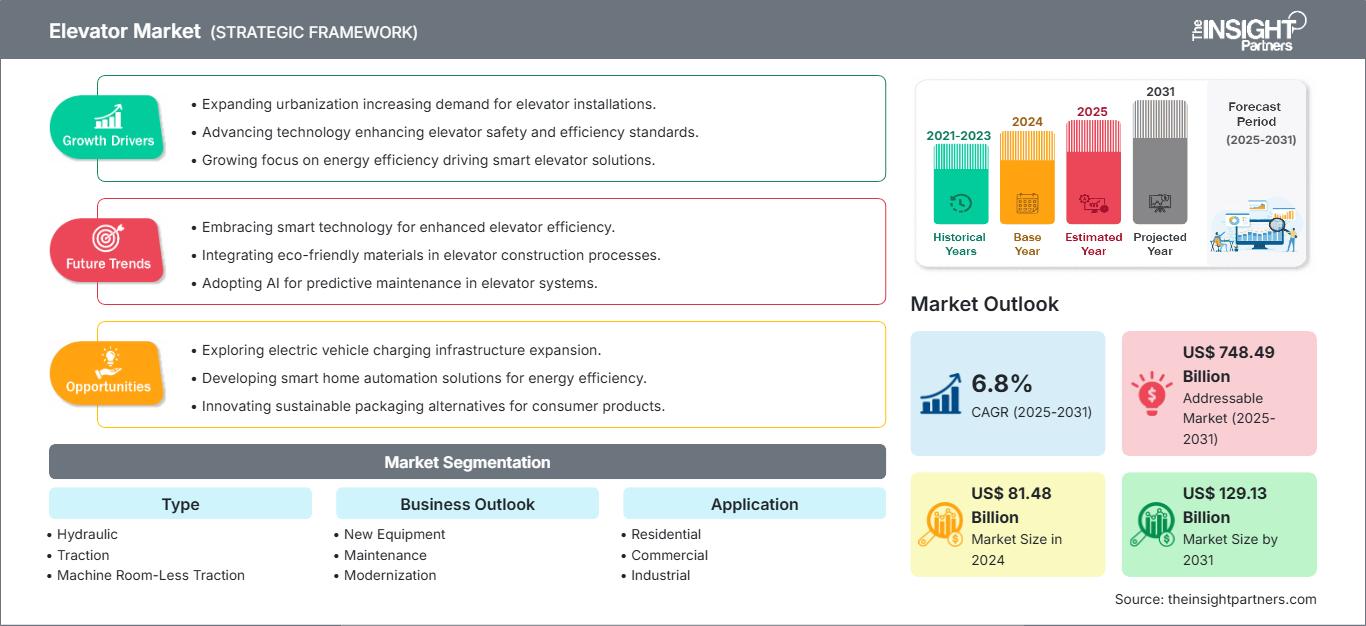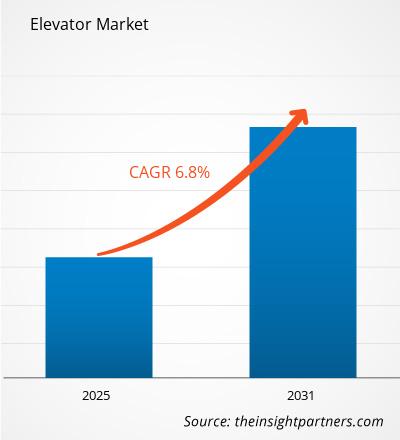The Elevator Market size is projected to reach US$ 129.13 billion by 2031 from US$ 76.29 billion in 2023. The market is expected to register a CAGR of 6.8% during 2023–2031. The growing adoption of green buildings is likely to remain a key trend in the market.
Elevator Market Analysis
- Growing accessibility in hospitals, airports, residential buildings, nursing homes, and supermarkets has become a topmost priority for governments globally. The elderly population needs products from the market to make their lifestyles more comfortable. Most senior individuals suffer from unavoidable illnesses such as arthritis issues or cardiovascular diseases. Deployment of elevators helps the aging population avoid painful flights of stairs; thus, the elevator market is attracting high demand from this section of society.
- Further, according to the United Nations Department of Economic and Social Affairs, Population Division, population and urbanization growth are projected to add 2.5 billion individuals to the world's cities by 2050. This scenario is expected to boost the construction industry, resulting in augmented demand. Elevators are extensively utilized in the construction sector for moving people and items from one floor to the next.
Elevator Market Overview
- Elevators are vertical transport berths housed in a platform or shaft for helping descend and ascend people or materials between levels and floors. Elevators are commonly operated by electric motors that power counterweight equipment and pump hydraulic fluid or traction cables to ascend a cylindrical system. Most of the multistorey buildings have elevators to facilitate aid of travel and wheelchair access laws.
- Further, elevators are extensively used in the construction industries for shipping goods and carrying people from one floor to another. Thus, the demand for elevators is expected to increase in both residential and commercial end-user segments during the forecast period.
Customize This Report To Suit Your Requirement
You will get customization on any report - free of charge - including parts of this report, or country-level analysis, Excel Data pack, as well as avail great offers and discounts for start-ups & universities
Elevator Market: Strategic Insights

-
Get Top Key Market Trends of this report.This FREE sample will include data analysis, ranging from market trends to estimates and forecasts.
Elevator Market Drivers and Opportunities
Growing Construction Industry
- The considerable rise in the world's population is facilitated by rising living standards, increased life expectancy, lower mortality, and the ongoing development of medical technology and medications. As a result, new housing developments are being established all over the world. This is likely to have a beneficial impact on market growth.
- A rising number of large-scale infrastructure investment plans in various developed and developing nations, such as hotels and hospitals, are expected to fuel the growth of the construction industry, generating demand for elevators in commercial buildings.
- Furthermore, expanding consumer spending capacity, combined with increased demand for single-family housing, is likely to encourage the use of elevators in residential building construction.
Rising Adoption of Smart Elevators
- Smart elevators are equipped with modern technology such as the Internet of Things (IoT), Artificial Intelligence (AI), cloud computing, and various software and hardware. These systems together allow for condition-based analysis, proactive, real-time data sharing, predictive maintenance, enhanced security, destination prediction, and several other features. A smart elevator is user-friendly, energy efficient, secure & safe, and experiences minimum downtime.
- Further, the rise in building construction and the increase in demand for green buildings are a few of the major drivers of the increasing demand for smart elevators. Furthermore, the rise in demand for smart elevators is attributed to the several features that set them apart from traditional elevators and place them in an advanced class.
- Conventional elevators are not very effective since their basic computing power cannot optimize the amount of time spent waiting by the end-users; additionally, they are not very energy efficient and do not incorporate any real-time monitoring of the elevator system. On the other hand, smart elevators are not only technologically improved but also have a wide variety of functions that contribute to their appeal among building developers. Thus, the demand for smart elevators is expected to increase during the forecast period.
Elevator Market Report Segmentation Analysis
key segments that contributed to the derivation of the Elevator Market analysis are type, business outlook, and application.
- Based on type, the Elevator Market is divided into hydraulic, traction, machine room-less traction, and others.
- On the basis of business outlook, the market is divided into new equipment, maintenance, and modernization.
- Based on application, the market is divided into residential, commercial, and industrial.
Elevator Market Share Analysis by Geography
- The Elevator Market report comprises a detailed analysis of five major geographic regions, which includes current and historical market size and forecasts for 2021 to 2031, covering North America, Europe, Asia-Pacific (APAC), Middle East and Africa (MEA), and South & Central America.
- Each region is further sub-segmented into respective countries. This report provides analysis and forecasts of 18+ countries, covering Elevator Market dynamics such as drivers, trends, and opportunities that are impacting the markets at the regional level.
- Also, the report covers PEST analysis, which involves the study of major factors that influence the Elevator Market in these regions.
Elevator Market Regional Insights
The regional trends and factors influencing the Elevator Market throughout the forecast period have been thoroughly explained by the analysts at The Insight Partners. This section also discusses Elevator Market segments and geography across North America, Europe, Asia Pacific, Middle East and Africa, and South and Central America.
Elevator Market Report Scope
| Report Attribute | Details |
|---|---|
| Market size in 2024 | US$ 81.48 Billion |
| Market Size by 2031 | US$ 129.13 Billion |
| Global CAGR (2025 - 2031) | 6.8% |
| Historical Data | 2021-2023 |
| Forecast period | 2025-2031 |
| Segments Covered |
By Type
|
| Regions and Countries Covered |
North America
|
| Market leaders and key company profiles |
|
Elevator Market Players Density: Understanding Its Impact on Business Dynamics
The Elevator Market is growing rapidly, driven by increasing end-user demand due to factors such as evolving consumer preferences, technological advancements, and greater awareness of the product's benefits. As demand rises, businesses are expanding their offerings, innovating to meet consumer needs, and capitalizing on emerging trends, which further fuels market growth.

- Get the Elevator Market top key players overview
Elevator Market News and Recent Developments
The Elevator Market is evaluated by gathering qualitative and quantitative data post primary and secondary research, which includes important corporate publications, association data, and databases. A few of the developments in the Elevator Market are listed below:
- TK Elevator, one of the global market and innovation leaders in the elevator industry, launched EOX in North America. The eco-efficient elevator platform is engineered to meet the demands of two- to 10-story buildings with its space-saving design, advanced technologies and reduced lead times. (Source: TK Elevator, Company Website, May 2023)
- TK Elevator, for the enhancement of smart and connected elevators, launched Application Programming Interfaces (APIs). These open interfaces connect elevators, buildings, and residents – allowing operators to automate some processes and end-users to control elevators through mobile applications. (Source: TK Elevator, Newsletter, November 2022).
Elevator Market Report Coverage and Deliverables
The “Elevator Market Size and Forecast (2021–2031)” report provides a detailed analysis of the market covering below areas:
- Elevator Market size and forecast at global, regional, and country levels for all the key market segments covered under the scope.
- Elevator Market trends as well as market dynamics such as drivers, restraints, and key opportunities.
- Detailed PEST/Porter’s Five Forces and SWOT analysis.
- Elevator Market analysis covering key market trends, global and regional framework, major players, regulations, and recent market developments.
- Industry landscape and competition analysis covering market concentration, heat map analysis, prominent players, and recent developments for the Elevator Market.
- Detailed company profiles.
Frequently Asked Questions
What is the expected CAGR of the Elevator Market?
What are the driving factors impacting the global Elevator Market?
What are the future trends of the Elevator Market?
Which are the leading players operating in the Elevator Market?
What are the deliverable formats of the Elevator Market report?
What are the options available for the customization of this report?
- Historical Analysis (2 Years), Base Year, Forecast (7 Years) with CAGR
- PEST and SWOT Analysis
- Market Size Value / Volume - Global, Regional, Country
- Industry and Competitive Landscape
- Excel Dataset
Recent Reports
Testimonials
Reason to Buy
- Informed Decision-Making
- Understanding Market Dynamics
- Competitive Analysis
- Identifying Emerging Markets
- Customer Insights
- Market Forecasts
- Risk Mitigation
- Boosting Operational Efficiency
- Strategic Planning
- Investment Justification
- Tracking Industry Innovations
- Aligning with Regulatory Trends





















 Get Free Sample For
Get Free Sample For